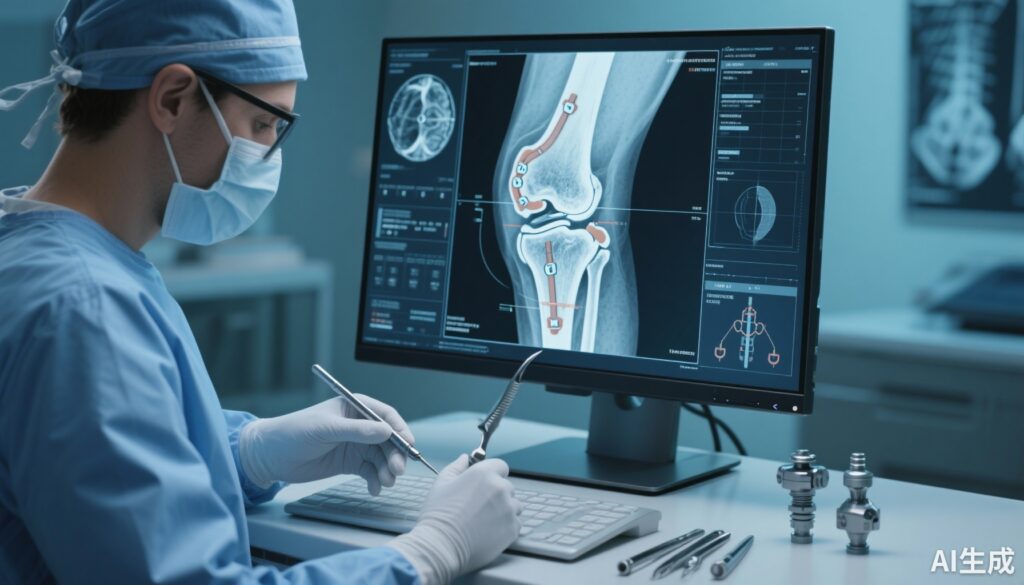Highlights
– Registry analysis of 189,932 TKAs found prior surgical osteotomy around the knee is associated with higher revision risk (HR 1.20, 95% CI 1.14–1.35) and greater use of revision components (2.5% vs 0.5%).
– Use of stems and/or augmentations predicted higher revision risk in both groups; prior osteotomy increased the likelihood that such components were required.
– Patient-reported pain and physical function (NRS, KOOS-PS, OKS) were similar between TKAs after osteotomy and primary TKAs at 6 and 12 months.
Background
Total knee arthroplasty (TKA) is a widely performed and effective procedure for end-stage knee osteoarthritis. Bony realignment osteotomies around the knee (for example, high tibial osteotomy [HTO] or distal femoral osteotomy [DFO]) are often used in younger, active patients with unicompartmental disease to postpone joint replacement and restore alignment. When osteotomy fails to prevent progression to symptomatic, multicompartment osteoarthritis, conversion to TKA is commonly required.
Surgeons have long recognized that performing TKA after a prior osteotomy can be more technically demanding. Potential issues include altered bony anatomy, deformity, bone loss, retained hardware, soft-tissue scarring, and ligamentous imbalance — factors that may necessitate stems, augments, or constrained implants. Whether these anatomic and technical challenges translate into worse implant survival or poorer patient-reported outcomes on a population level has been uncertain.
The study summarized here used the Dutch Arthroplasty Register to compare implant survival, implant complexity, and early clinical outcomes between TKAs performed after prior osteotomy and primary TKAs without a prior osteotomy.
Study design
This was a registry-based cohort study including procedures registered in the Dutch Arthroplasty Register from 2007 through 2022. Inclusion criteria were:
– Total knee arthroplasty for osteoarthritis as the primary diagnosis.
– Age ≥18 years at time of procedure.
Key analytical methods:
– Kaplan–Meier survival analysis to estimate cumulative implant survival up to 15 years.
– Multivariable Cox proportional hazards regression to estimate adjusted hazard ratios (HR) for revision, comparing TKAs after prior osteotomy with primary TKAs.
– Analysis of the use of revision components (defined as components with stems and/or augmentations) as both an outcome and stratification factor.
– Patient-reported outcome measures (PROMs) collected preoperatively and at 6 and 12 months included Numeric Rating Scales (NRS) for pain at rest and during activity, the Knee Injury and Osteoarthritis Outcome Score Physical Function Short Form (KOOS-PS), and the Oxford Knee Score (OKS).
The registry design provides large numbers and real-world generalizability but lacks the granularity of some surgical- or imaging-specific variables (for example, whether hardware was retained, type of osteotomy, time from osteotomy to TKA, or detailed intraoperative bone loss grading).
Key findings
Cohort and follow-up
– The analysis included 189,932 TKA procedures. Median follow-up for the whole cohort was 4.1 years (IQR 5.0). Survival estimates were reported up to 15 years.
Implant survival and revision risk
– Primary TKAs demonstrated higher cumulative implant survival through 15-year follow-up compared with TKAs performed after prior osteotomy.
– The adjusted hazard ratio for revision for TKAs after prior osteotomy compared with primary TKAs was 1.20 (95% CI 1.14–1.35), indicating a statistically significant ~20% higher revision hazard.
– The proportion of TKAs that used revision components (stems and/or augmentations) was greater after prior osteotomy than in primary TKAs (2.5% vs 0.5%, p < 0.001).
– Across both groups, the use of revision components was associated with an increased revision risk, and this effect was amplified in cases with prior osteotomy.
Patient-reported outcomes
– Despite differences in implant survival and component usage, there were no clinically meaningful differences between groups in early PROMs. Measures of pain at rest and during activity (NRS), KOOS-PS, and OKS were similar preoperatively and at 6- and 12-month follow-up.
Clinical interpretation of effect sizes
– The observed HR of 1.20 represents a modest but meaningful increase in revision risk at the population level. The absolute increase in use of revision components (2.0 percentage points) is small but indicates a higher likelihood of intraoperative complexity.
– The lack of short-term PROM differences suggests that—when surgery is accomplished—patients derive symptomatic benefit similar to primary TKA patients in the first postoperative year.
Expert commentary and mechanistic considerations
Why might prior osteotomy increase revision risk?
– Altered bone geometry and alignment: Osteotomies change the anatomy and can produce bone deformities or asymmetry that complicate implant positioning and fixation.
– Bone loss and need for augmentation: Prior osteotomy and any subsequent bone remodeling or grafting may create deficient bone stock that requires augments or stems.
– Hardware-related issues: Retained osteotomy hardware may necessitate removal—sometimes staged—which raises infection and mechanical complication risks.
– Soft-tissue scarring and ligament imbalance: Previous surgery modifies soft-tissue planes and can make balancing the knee more difficult, potentially increasing implant stress and failure risk.
Clinical implications
– Preoperative planning is essential for TKAs after osteotomy. Surgeons should obtain advanced imaging when needed (long-leg alignment films, CT for rotational deformities), plan for possible hardware removal, and have a range of implant options (stems, augments, constrained inserts) available.
– Counseling: Patients should be informed that conversion TKA after osteotomy carries a higher revision risk and that intraoperative decisions to escalate to revision components are not uncommon.
– Surgical strategy: Experienced arthroplasty teams, careful templating, and low threshold for using stems/augments in the presence of bone loss or instability may improve outcomes.
Limitations and generalizability
– Residual confounding: Registry data lack some detailed clinical variables (osteotomy type, time from osteotomy to conversion, status of hardware, body mass index, surgeon volume), which may affect revision risk.
– Selection bias: Patients selected for osteotomy earlier in life may differ systematically (age, activity levels, knee pathology) from those receiving primary TKA.
– PROM follow-up limited to early postoperative time points (6 and 12 months). Long-term functional trajectories were not reported.
– Lack of granular surgical detail prevents identification of which osteotomy subtypes or technical factors confer the highest risk.
These limitations reduce causal inference but do not negate the practical signal: prior osteotomy is a marker for greater procedural complexity and modestly higher revision risk.
Practice implications and recommendations
1) Preoperative assessment: Obtain full-length alignment radiographs and consider CT if rotational deformity is suspected. Evaluate prior osteotomy type and whether hardware is in situ.
2) Operative readiness: Plan for potential hardware removal, bone grafting, stems and augments, and constrained or revision-level solutions. Inform the patient about these possibilities preoperatively.
3) Surgeon experience and referral: Complex conversions may benefit from experienced arthroplasty surgeons or referral to centers with access to revision implants and multidisciplinary teams.
4) Shared decision-making: For younger patients with unicompartment disease, clinicians should discuss the lifetime risk of subsequent TKA and the potential increased complexity if osteotomy fails.
Research gaps and future directions
– Granular registry linkage or prospective cohorts that record osteotomy type (HTO vs DFO), hardware status, time interval to TKA, and intraoperative bone loss grading would allow risk stratification.
– Studies comparing staged hardware removal versus single-stage removal at conversion TKA could clarify infection and mechanical risk trade-offs.
– Long-term PROM trajectories beyond 1 year would help determine whether similar early functional gains persist.
– Investigation into whether surgeon volume and center specialization modify the increased revision risk after osteotomy is warranted.
Conclusion
This large Dutch registry analysis demonstrates that total knee arthroplasty following a prior osteotomy around the knee is associated with a modestly increased hazard of revision and more frequent use of stems and augmentations, reflecting higher intraoperative complexity. Despite these differences in implant survival and implant selection, short-term pain relief and functional improvement (to 12 months) appear similar to primary TKA. Clinicians should incorporate these findings into preoperative planning, patient counseling, and intraoperative preparedness. Future work should aim to characterize which osteotomy-related factors carry the highest risk and whether targeted surgical strategies can mitigate the increased revision hazard.
Funding and clinicaltrials.gov
This work was a registry analysis of the Dutch Arthroplasty Register; no specific funding source is stated in the referenced report. As an observational registry study, it was not registered in ClinicalTrials.gov.
References
Huizinga MR, de Vries AJ, van Steenbergen LN, Brouwer RW. Lower survival, higher surgical complexity, but no difference in physical functioning and pain in total knee arthroplasty following osteotomy versus primary total knee arthroplasty without osteotomy: Analysis of 189,932 procedures of the Dutch Arthroplasty Register. Knee Surg Sports Traumatol Arthrosc. 2025 Sep 9. doi: 10.1002/ksa.70013. Epub ahead of print. PMID: 40923449.



